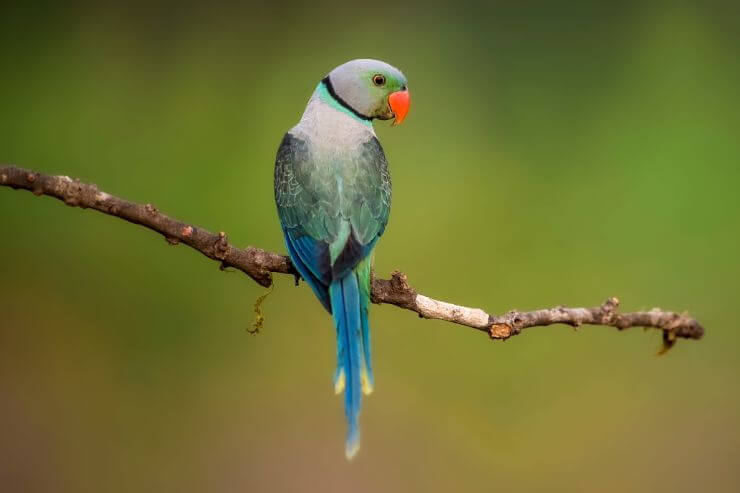The parakeet is a beloved pet bird owned by millions – they’re the most popular pet parrot around the world, likely due to their friendliness, tameability, and more affordable needs in comparison to many parrots. Technically, ‘parakeet’ refers to a number of species – long-tailed, small-to-medium sized members of the parrot family – but when discussing pets, ‘parakeet’ almost solely refers to the budgerigar or budgie (Melopsittacus undulatus), commonly known as a parakeet.
The only pet parrot that’s achieved selective breeding to the point of showing traits of domestication, the budgie is well-beloved for good reason. However, many first-time owners may find themselves in over their head, not knowing how to properly care for these birds, or even how long their lifespan is. We’re here to share more about parakeets’ lifespans, and how you can assist your parakeet in living the longest life possible.
How Long Do Parakeets Live?
Parakeets may have a range in lifespan depending on several different factors. For example, pet store-bought parakeets are often bred without much care for health or wellness, meaning these birds may not live as long as birds bought from a reputable breeder. If you’re opting to buy a parakeet rather than adopt from a shelter or rescue, finding a breeder known for prioritizing breeding for health is a good way to tip the odds towards your bird having a long lifespan.

Many captive bred budgies unfortunately suffer from illnesses related to inbreeding or poor genetic lines, so finding a responsible parakeet breeder can help you get matched with a bird who has a better shot at living a long life.
In the wild, a parakeet’s lifespan isn’t particularly long. These Australian parrots face many predators, harsh weather conditions, and unpredictable food supply, meaning that most birds survive for a maximum of 4-6 years. It’s possible for them to exceed this lifespan, but most birds sadly succumb to the harsh reality of wild life.
In captivity, budgies can have slightly longer lifespans – or even live for decades. While some say the average lifespan for budgies is 5-8 years, many birds live for 10-15 years or more with proper care. Genetics and good care practices play a large part into how long budgies will live. So, if you’re looking to have your budgie live for quite a while, it’s best to select a bird with good genetics, and dedicate time to giving them a good diet, veterinary care, and daily playtime.
How To Help Parakeets Live Longer
If you have a pet parakeet, and you’re trying to help them live the longest lifespan possible, there are steps you can take to provide them with the best quality of care & support them in living a happy, healthy lifestyle.

Poor nutrition is sadly a big issue for many pet birds. To give your bird the nutrition they deserve, a good starting point is offering them a balanced diet sold by a reputable brand along with fresh fruits and veggies daily. Fresh food is important for parrots’ diets, including parakeets, so don’t miss out on offering these foods to your bird.
Remember to also offer cuttlebone, which is a good source of calcium; however, contrary to popular belief, grit is not necessary in the diet of parakeets, so do not offer it unless instructed to by a vet. If you’re unsure on what you can or cannot offer, an avian vet can give you guidance on what you should be feeding your feathered friend.
It’s also crucial that parakeets’ social needs are met. Parakeets are incredibly social birds in the wild, and while they love human company, they do best when kept with at least one other parakeet for company. Keeping a parakeet by itself will result in unnecessary stress and potentially manifest in undesirable behaviors such as feather plucking and screaming.
Ideally, your parakeet should have a roomy cage, with different options for toys and perches to keep them entertained. Flat wooden perches can damage the bird’s feet over time and cause conditions such as bumblefoot, so try to offer perches of different textures, such as those that still have natural bark. Provide at least 3-4 different toy options; parakeets are intelligent animals that crave stimulation and ways to engage their mind, so be sure to give them ample ways to entertain themselves.

Although it may seem overcautious, taking your bird to an avian vet for a yearly checkup, like you’d do for a cat or dog, can prevent illnesses and keep your bird healthy in the long term. It’s easier to prevent an ailment in a parakeet – parakeets easily hide symptoms of illness, so treating them once they’re sick can be difficult and sadly, sometimes help comes too late.
All around, paying attention to your parakeet’s wants and needs and providing them with an interesting, social life will help them live happier, healthy lives, which increases longevity.
Conclusion
Many pet parrots are famed for their abilities to outlive their human owners, such as in the case of many macaws and African Greys, who can live upwards of sixty years. While that’s not the case with parakeets, who rarely live upwards of fifteen years, proper care goes a long way in giving your parakeet a longer, healthier life.
Giving your parakeet what they need will hopefully give you many years to enjoy with your feathered friend. If you’re seeking a pet bird that can remain with you for decades to come, a parakeet may not be the best choice – but if you’re looking for a friendly pet bird with easier care requirements, the humble parakeet is a wonderful addition to many households.



